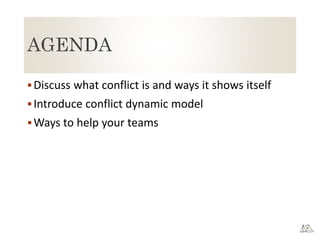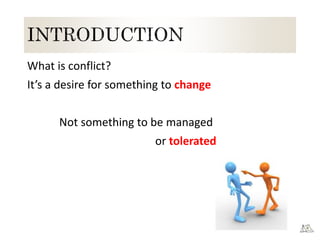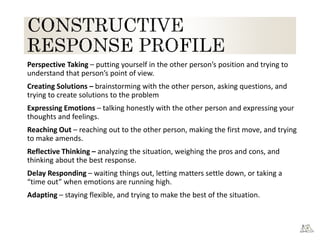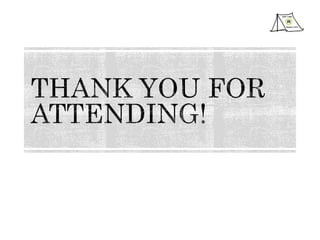Agile camp conflict
- 2. AGENDA Discuss what conflict is and ways it shows itself Introduce conflict dynamic model Ways to help your teams
- 3. What is conflict? It’s a desire for something to change Not something to be managed or tolerated
- 4. Form 2-3 groups Each group talk about their set of cards What they mean How this is conflict Do you behave/act in one of these ways? See your teammates behave/act in these ways?
- 6. Perspective Taking – putting yourself in the other person’s position and trying to understand that person’s point of view. Creating Solutions – brainstorming with the other person, asking questions, and trying to create solutions to the problem Expressing Emotions – talking honestly with the other person and expressing your thoughts and feelings. Reaching Out – reaching out to the other person, making the first move, and trying to make amends. Reflective Thinking – analyzing the situation, weighing the pros and cons, and thinking about the best response. Delay Responding – waiting things out, letting matters settle down, or taking a “time out” when emotions are running high. Adapting – staying flexible, and trying to make the best of the situation.
- 7. Winning at All Costs – arguing vigorously for your own position and trying to win at all costs. Displaying Anger – expressing anger, raising your voice, and using harsh, angry words. Demeaning Others – laughing at the other person, ridiculing the other’s ideas, and using sarcasm. Retaliating – obstructing the other person, retaliating against the other, and trying to get revenge. Avoiding – avoiding or ignoring the other person, and acting distant and aloof. Yielding – giving in to the other person in order to avoid further conflict. Hiding Emotions – concealing your true emotions even though feeling upset. Self-Criticizing – replaying the incident over in your mind, and criticizing yourself for not handling it better.
- 8. • Create a common language (i.e., Conflict Dynamic Model) • Be self-aware of who you are, who you WANT to be • Create and use Conflict Protocols • How do we want it to be when we’re in conflict? • How will we surface conflict? • What do you know about yourself in dealing with conflict? • Make agreements on culture and behavior.
- 9. • Behavior • 24 hour rule: address it within a day or drop it • Let go of old issues or stories • Depersonalize conflict: keep it about the issue, not the people • Culture • Respect each other and different perspectives • Assume positive intent • Humor when it gets tough or heavy
Editor's Notes
- Conflict is normal
- Activity: Form 2-3 groups in the room Have groups talk about each quadrant of the model reflecting on how they act/behave Discuss the differences Discuss any observations they may have had
- Constructive is TASK FOCUSED
- Destructive is PERSON-FOCUSED
- Right View: Conflicting positions are important voices of that system What is conflict? It’s a desire for change – not something to be managed or tolerated Container It’s normal and expected Create a common language for your team (i.e., the Conflict Dynamic Model) Increase positivity while decreasing toxic communication Establish protocols Role Be a conflict facilitator… not a mediator or problem solver Manage your own triggers Practice seeing everyone as RIGHT (at least partly) Process Use the Conflict Dynamic Model to help your team move toward constructive behaviors Create and use Conflict Protocols to keep positivity high and toxic communications low Create an environment where different perspectives are genuinely respected









